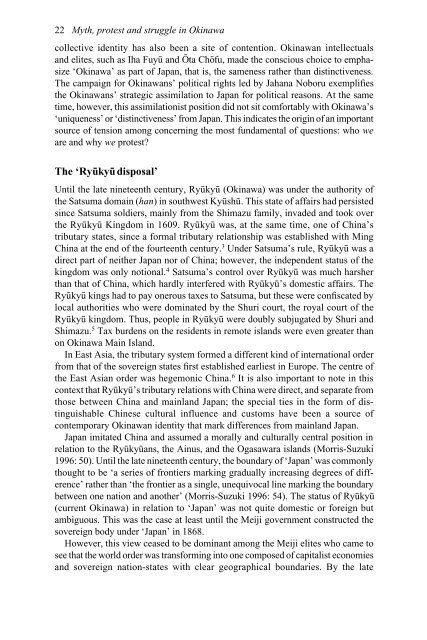Myth, Protest and Struggle in Okinawa
Myth, Protest and Struggle in Okinawa
Myth, Protest and Struggle in Okinawa
Create successful ePaper yourself
Turn your PDF publications into a flip-book with our unique Google optimized e-Paper software.
22 <strong>Myth</strong>, protest <strong>and</strong> struggle <strong>in</strong> Ok<strong>in</strong>awa<br />
collective identity has also been a site of contention. Ok<strong>in</strong>awan <strong>in</strong>tellectuals<br />
<strong>and</strong> elites, such as Iha Fuyū <strong>and</strong> Ōta Chōfu, made the conscious choice to emphasize<br />
‘Ok<strong>in</strong>awa’ as part of Japan, that is, the sameness rather than dist<strong>in</strong>ctiveness.<br />
The campaign for Ok<strong>in</strong>awans’ political rights led by Jahana Noboru exemplifies<br />
the Ok<strong>in</strong>awans’ strategic assimilation to Japan for political reasons. At the same<br />
time, however, this assimilationist position did not sit comfortably with Ok<strong>in</strong>awa’s<br />
‘uniqueness’ or ‘dist<strong>in</strong>ctiveness’ from Japan. This <strong>in</strong>dicates the orig<strong>in</strong> of an important<br />
source of tension among concern<strong>in</strong>g the most fundamental of questions: who we<br />
are <strong>and</strong> why we protest?<br />
The ‘Ryūkyūdisposal’<br />
Until the late n<strong>in</strong>eteenth century, Ryūkyū (Ok<strong>in</strong>awa) was under the authority of<br />
the Satsuma doma<strong>in</strong> (han) <strong>in</strong> southwest Kyūshū. This state of affairs had persisted<br />
s<strong>in</strong>ce Satsuma soldiers, ma<strong>in</strong>ly from the Shimazu family, <strong>in</strong>vaded <strong>and</strong> took over<br />
the Ryūkyū K<strong>in</strong>gdom <strong>in</strong> 1609. Ryūkyū was, at the same time, one of Ch<strong>in</strong>a’s<br />
tributary states, s<strong>in</strong>ce a formal tributary relationship was established with M<strong>in</strong>g<br />
Ch<strong>in</strong>a at the end of the fourteenth century. 3 Under Satsuma’s rule, Ryūkyū was a<br />
direct part of neither Japan nor of Ch<strong>in</strong>a; however, the <strong>in</strong>dependent status of the<br />
k<strong>in</strong>gdom was only notional. 4 Satsuma’s control over Ryūkyū was much harsher<br />
than that of Ch<strong>in</strong>a, which hardly <strong>in</strong>terfered with Ryūkyū’s domestic affairs. The<br />
Ryūkyū k<strong>in</strong>gs had to pay onerous taxes to Satsuma, but these were confiscated by<br />
local authorities who were dom<strong>in</strong>ated by the Shuri court, the royal court of the<br />
Ryūkyū k<strong>in</strong>gdom. Thus, people <strong>in</strong> Ryūkyū were doubly subjugated by Shuri <strong>and</strong><br />
Shimazu. 5 Tax burdens on the residents <strong>in</strong> remote isl<strong>and</strong>s were even greater than<br />
on Ok<strong>in</strong>awa Ma<strong>in</strong> Isl<strong>and</strong>.<br />
In East Asia, the tributary system formed a different k<strong>in</strong>d of <strong>in</strong>ternational order<br />
from that of the sovereign states first established earliest <strong>in</strong> Europe. The centre of<br />
the East Asian order was hegemonic Ch<strong>in</strong>a. 6 It is also important to note <strong>in</strong> this<br />
context that Ryūkyū’s tributary relations with Ch<strong>in</strong>a were direct, <strong>and</strong> separate from<br />
those between Ch<strong>in</strong>a <strong>and</strong> ma<strong>in</strong>l<strong>and</strong> Japan; the special ties <strong>in</strong> the form of dist<strong>in</strong>guishable<br />
Ch<strong>in</strong>ese cultural <strong>in</strong>fluence <strong>and</strong> customs have been a source of<br />
contemporary Ok<strong>in</strong>awan identity that mark differences from ma<strong>in</strong>l<strong>and</strong> Japan.<br />
Japan imitated Ch<strong>in</strong>a <strong>and</strong> assumed a morally <strong>and</strong> culturally central position <strong>in</strong><br />
relation to the Ryūkyūans, the A<strong>in</strong>us, <strong>and</strong> the Ogasawara isl<strong>and</strong>s (Morris-Suzuki<br />
1996: 50). Until the late n<strong>in</strong>eteenth century, the boundary of ‘Japan’ was commonly<br />
thought to be ‘a series of frontiers mark<strong>in</strong>g gradually <strong>in</strong>creas<strong>in</strong>g degrees of difference’<br />
rather than ‘the frontier as a s<strong>in</strong>gle, unequivocal l<strong>in</strong>e mark<strong>in</strong>g the boundary<br />
between one nation <strong>and</strong> another’ (Morris-Suzuki 1996: 54). The status of Ryūkyū<br />
(current Ok<strong>in</strong>awa) <strong>in</strong> relation to ‘Japan’ was not quite domestic or foreign but<br />
ambiguous. This was the case at least until the Meiji government constructed the<br />
sovereign body under ‘Japan’ <strong>in</strong> 1868.<br />
However, this view ceased to be dom<strong>in</strong>ant among the Meiji elites who came to<br />
see that the world order was transform<strong>in</strong>g <strong>in</strong>to one composed of capitalist economies<br />
<strong>and</strong> sovereign nation-states with clear geographical boundaries. By the late
















